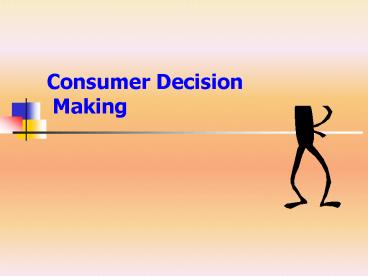Consumer Decision Making - PowerPoint PPT Presentation
1 / 21
Title:
Consumer Decision Making
Description:
Little Thought, Search, or Time Given to Purchase ... Inept Set. Aware of, But. Would Not Buy. Aware. Alternatives. Evaluation of Alternatives ... – PowerPoint PPT presentation
Number of Views:53
Avg rating:3.0/5.0
Title: Consumer Decision Making
1
Consumer Decision Making
2
Types of Buying Decision Behavior
Low-Cost Products
More Expensive Products
Frequent Purchasing
Infrequent Purchasing
Low Consumer Involvement
High Consumer Involvement
Unfamiliar Product Class and Brands
Familiar Product Class and Brands
Little Thought, Search, or Time Given to Purchase
Extensive Thought, Search, and Time Given to
Purchase
3
Consumer Decision Making Process
Problem Recognition
Information Search
Evaluation of Alternatives
Product Choice
Outcomes
4
Problem Recognition
Occurs when significant difference between
Current State and Some Desired or Ideal State of
a consumer
- Consumers Desired State
Need Recognition
Opportunity Recognition
- Consumers Actual State
5
Gap between Ideal and Actual states
IDEAL
Need Recognition (consumer)
ACTUAL
IDEAL
Opportunity Recognition (marketer)
ACTUAL
6
Strategic Implications
- Influence of marketers
- Discover consumer problems
- Respond
- Create awareness of problems
- Influence desired state
- Influence actual state
7
Information Search
- Types of Search
- Prepurchase - an explicit search for information
- Ongoing Search - browsing used by consumers for
up-to-date information - Information Sources
- Internal Search - memory scan to assemble
information. - External Search - information obtained from ads,
friends, experts etc.
8
Information Search
- Do consumers always search rationally?
- Costs and benefits
- What do consumers search for?
- How much do consumers search?
- Market characteristics/type of product
- Perceived risk
- Individual characteristics
- Prior Knowledge
- Locus of control
- Confidence
9
Marketing implications of understanding search
behavior
- Integrate critical role of the Internet
- Types of strategies
- Maintenance
- Disrupt
- Capture
- Intercept
- Preference
- Acceptance
10
Types of Perceived Risk
- Performance risk
- Psychological risk
- Social risk
- Financial risk
- Physiological risk
11
Alternatives
Aware Alternatives
Evoked Set Actively Considered
Inert Set Not Entering Consideration
Inept Set Aware of, But Would Not Buy
12
Evaluation of Alternatives
- Rational consumers
- Bounded rationality
- Affective choice
- Attribute-based vs. attitude-based choice
13
Evaluation of Alternatives
- Setting Evaluative Criteria
- Determinant attributes
- Which criteria are relevant or used
- Relative importance of these criteria
- Evaluating alternatives against these criteria
using some decision rule - Performance of the alternatives on the above
criteria
14
Evaluation process
- Often a Phased Decision Strategy
- Alternative elimination stage
- Alternative selection stage
- Decision Rules
- Decision Heuristics
- Rule-of-thumbs or short cuts
- Affective choice
15
Decision Rules
Conjunctive
Noncompensatory Decision Rules
Compensatory Decision Rules
Simple Additive
Disjunctive
Weighted Additive
Elimination-By-Aspects
Lexicographic
16
Compensatory Rules
- Simple additive
- All criteria (features) are considered
- All criteria are given equal importance
- Weighted additive
- All criteria (features) are considered
- criteria are given differential weights according
to importance
17
Conjunctive
- Minimum cutoffs set on relevant attributes
- Any alternative (brand) that does not meet the
cutoff on even one attribute is dropped from
further consideration - What happens when there is more than one
alternative that meets these cutoffs?
18
Disjunctive
- Entails trade-offs between aspects of different
brands (alternatives) - Minimum cutoffs are set
- Brands that meet the cutoff on any attribute are
selected for further consideration
19
Elimination-By-Aspects (EBA)
- Rank the evaluative criteria in terms of their
importance - Establish a cutoff point for each criterion
- Brands that do not meet the cutoff on the most
important criterion are dropped - Then, repeat the process for the next important
criterion
20
Lexicographic
- Rank the evaluative criteria in terms of their
importance - Select the brand that does best on the most
important criterion - If there is a tie, compare these brands on the
second most important criterion
21
Decision Heuristics
- Price
- Brand reputation
- Market beliefs
- Product cues































